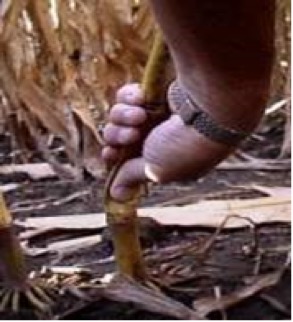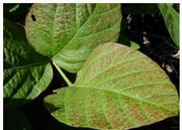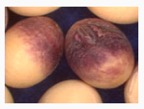Brought to you by: Jonah T. Johnson, MS, CPAg, CCA - Sales Agronomist, PCT | Sunrise
October 1, 2019: Watch for corn stalk lodging, soybean harvest loss and Cercospora leaf blight!
The 2019 harvest is well in progress in some locations across Ohio. Extremely dry conditions coupled with high heats have expedited the maturation process for many geographies. Growers hoped for warmer temperatures to accumulate much needed heat units for corn and soybeans to reach maturity prior to a killing frost but coupled with very little rainfall could create harvest and plant standability issues.
Several topics of recent interest among growers have been stalk quality in corn, preventing soybean harvest loss and why do I have purple soybeans in my combine?
Stalk Lodging
Moderate to high yield potential + high heat and minimal rain events = A recipe for potential stalk lodging!
Yields have been very respectable thus far; however, large ears, weak stalks that had to give up carbohydrate reserves to fill the ear. Growers should continue to scout fields and prioritize harvest based on stalk quality.
- When the carbohydrate demands of the developing kernels exceed the supply produced by the leaves, stalk and root storage reserves are tapped.
- Environmental stresses which decrease the amount of photosynthate produced by the plant can force plants to extract even greater percentages of stalk carbohydrates, which preserves grain fill rates at the expense of the stalk.
- Photosynthesis is most efficient in full sunlight. Prolonged cloudy conditions during ear fill often result in severely depleted stalk reserves.
- When favorable conditions exist when the number of kernels per ear are being established, stress conditions during ear fill may render the plant unable to produce enough sugars at the expense of stalks.
- Certain plant characteristics other than stalk strength can influence a hybrid’s potential for lodging. Hybrid maturity determines the plant’s developmental stage when environmental stresses occur, which impacts stalk quality.
- Oftentimes, small differences between fields or between areas in the same field can determine whether corn stands or lodges after a wind event.
- Scouting fields ahead of harvest can help determine the best place to go with the combine. Pinch the stalk at the 1st or 2nd elongated internode above the ground. If it collapses … watch out! Push stalks about 8-12 inches sideways at ear level. Stalks that crimp near the base or fail to return to vertical indicate stalk rot. Check 20 plants in five areas. If 10-15% crimp, consider early harvest!

Early soybean yield reports have been quite variable. But many farmers are commenting that the beans are drier than they appear.
As soybeans go through the process of drying and then picking up moisture again due to rains or overnight dews the pods can begin to shatter. A loss of 4 or 5 beans per square foot is equal to 1 bushel per acre.
It is estimated that roughly 80% of all harvest losses occur at the combine. The following practices can help reduce these losses.
- Be sure knife sections and ledger plates are sharp, and that wear plates, hold-down clips, and guards are properly adjusted. Chains and bearings should be properly lubricated, and belts tight.
- Proper reel speed in relation to ground speed will reduce gathering losses. Shatter increases if the reel turns too fast; stalks may be dropped if the reel turns too slow. Use a reel speed about 25% faster than ground speed.
- The reel axle should be six to 12 inches ahead of the sickle in most cases. The tips of the fingers on a pickup reel should clear the cutterbar by about two inches.

Several calls came in last week with a peculiar leaf purpling on individual fields/varieties. The pictures sent to me resembled Cercospora Leaf Blight, a mostly cosmetic disease that isn’t commonly seen across the area. The disease is more common in warm/wet years and will mostly show a purple staining on the harvested soybeans more than any type of yield losses.

CLB could have been controlled with a foliar fungicide, but obviously we are well beyond the point where one would consider that as a management option. It is very environmentally driven, so the best management advice to pass along is to take note of the field infested and plan on a fungicide management option the next time the field is in soybeans.